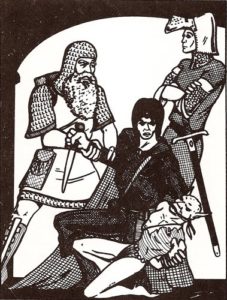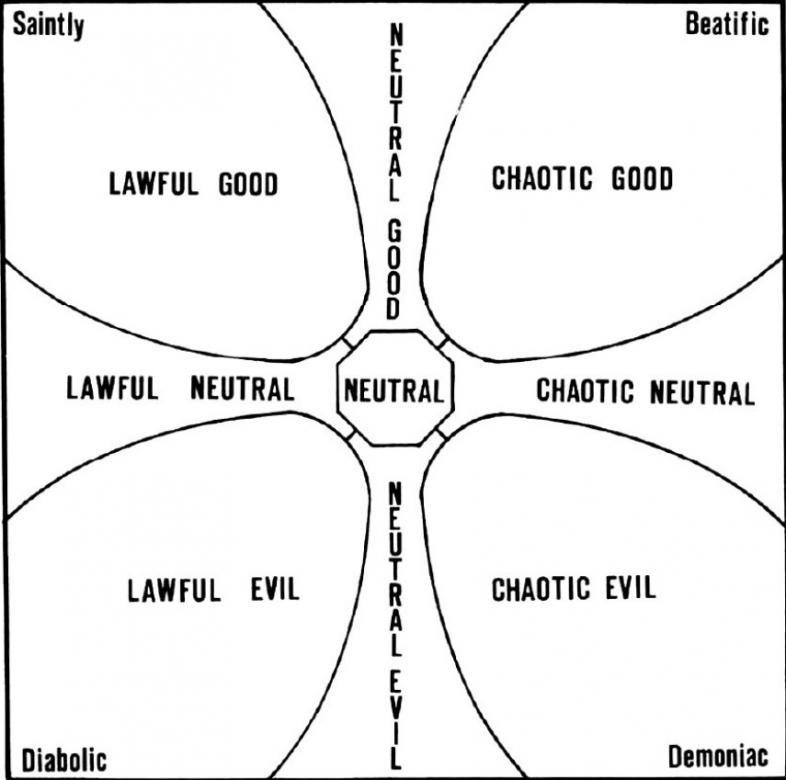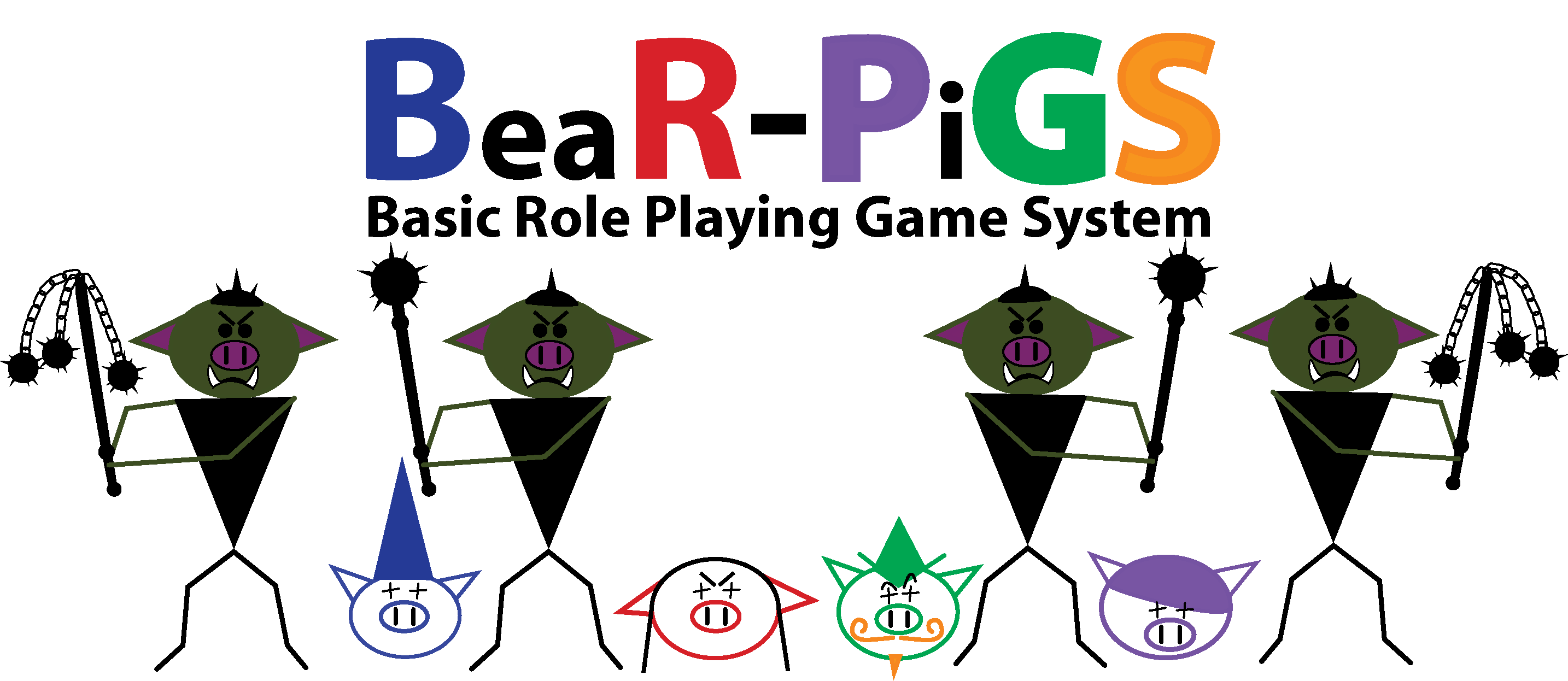A vestige of bygone days?
In the 1980’s gamers who were fortunate enough to play the boxed “basic” set of Dungeons & Dragons (Moldvay edition) were greeted with the classic David “Diesel” S Laforce illustration depicting a moral conflict amongst three characters and a goblin.

The description of the alignments in the text were analogous to the actions of the characters in the illustration, with one black-clad character’s dagger-hand being restrained by a bearded character, another character looks on, seemingly unaffected by the other’s actions. This illustration appears to depict the actions of Chaotic, Lawful, and Neutral alignments respectfully.
The Advanced Dungeons & Dragons Player’s Handbook possessed an even more complex system than its juvenile cousin with the inclusion of good, neutral, and evil.
Player’s Handbook possessed an even more complex system than its juvenile cousin with the inclusion of good, neutral, and evil.
These three sub-alignments could then be combined with chaotic, lawful, and neutral thereby creating nine alignments.
No Politics!
A modern analogy of alignments could be the two major opposing political spectrums in the U.S. and beyond: Conservativism vs. Liberalism.
Reimaging alignment by substituting Conservative for Lawful and Liberal for Chaotic could result in combinations such as “Liberal Good” or “Conservative Evil” or conversely “Conservative Good” vs. “Liberal Evil.”
This reorganizing could do much to in terms of making alignment more understandable… or perhaps due to the misunderstandings of both political ideologies it would only encourage division and disagreement at the gaming table.
Maybe alignment should be discarded all-together and something better could replace the outdated alignment concept?
Something Better?
While the political spectrum is a good replacement for alignment, it is probably best to keep modern politics out of a role-playing games.
What about a system that would allow a player to make character personality choices based on a popular personality test?
The Myers-Briggs System can do just that. Inspired by the Jungian concept that people experience the world according to each individual’s emphasis on the following attitudes: Extroversion vs. Introversion and the following functions Sensing vs. Intuition, Feeling vs. Thinking.
These attitudes & functions are then governed by a fourth category that dictates whether an individual relies more on a structured and decided lifestyle (Judging) or a more flexible and adaptable lifestyle (Perceiving).
These attitudes and functions can then be combined much like the alignments of D&D to create 16 personality types.
According to 16personalities.com, there are four supra-classes of personality types, that as an interesting aside, are loosely analogous to the the 4 archetypal classes of D&D!
- ANALYSTS (Magicusers)
Intuitive (N) and Thinking (T) personality types, known for their rationality, impartiality, and intellectual excellence.
- DIPLOMATS (Clerics)
Intuitive (N) and Feeling (F) personality types, known for their empathy, diplomatic skills, and passionate idealism.
- SENTINELS (Fighters)
Sensing (S) and Judging (J) personality types, known for their practicality and focus on order, security, and stability.
- EXPLORERS (Thieves)
Sensing (S) and Perceiving (P) personality types, known for their spontaneity, ingenuity, and flexibility.
What if the dungeon master asked you three simple questions about your character instead of asking for alignment? How does your character interact with their world, as an Extrovert or an Introvert? How does your character gather information, through Sensory Observation or through their Intuition? How does your character process information, through Thinking or Feeling?’
Would this improve your role-playing or do you prefer the classic alignment system to influence your character’s actions?


That could be very interesting to tryout. Might be hard for me to break the old method, Also, that picture is by David S LaForce, aka Diesel.
Thank-you for your comment and CORRECTION!
I thought I knew artists I don’t!
Editing now!
“Lawful” and “Chaotic” do not correspond to “Conservative” or “Liberal”. Generally speaking, the larger and more regulated a society, the more lawful it is. Small bands, tribal groups, and frontier towns tend more toward chaotic. Huge bureaucracies are lawful. Many figures of American folklore can be considered Chaotic Good, as can the romanticized spirit of early colonial America. The political party closest might be the Libertarian party.
So are libertarians Chaotic Good? Aren’t they supposed to be evil and selfish? Well, some might be. There can be Chaotic Good Libertarians, as well as Lawful Evil ones. Likewise, Democrats and Republicans can also be all over the alignment spectrum, and there are plenty of real-life examples of this, none of which I will actually name here.
Of course, I’d imagine there would be SOME alignment restrictions in regard to politics. An Anarchist, for instance, could never be lawful. And Fascism seems like an innately cynical philosophy, either Lawful or Neutral Evil. Communism would have to be lawful by default.
But other than that, it’s a basic fact of human nature that we love to hate each other for imaginary differences. Gygax was well aware of this, too, and in the ’79 DMG he even noted that two characters could be of the same alignment and be bitter rivals or even mortal enemies. One example in the DMG states that two nations of humans could both have Lawful Good rulers and be at war with each other. And two orc tribes could both be Lawful Evil and constantly fighting each other. But Gygax believed that the two LG human nations would put aside their difference to fight off the impending orc invasion, just as the two LE orc tribes might unite to oppose the humans.
So no, substituting politics for alignment isn’t going to help. It would be no different from introducing factions, and the Planescape setting has already done a better job with that.
Likewise, utilizing something like the Myer-Briggs typology might help you understand your character better (if you actually understand the functions and not just the words of the letter combination), but it isn’t a substitute for your characters’ ethos or worldview. You could easily find every alignment represented across all 16 types.
I think alignment, for all of its flaws, remains a fairly useful system, provided you understand it’s only meant to be a very broad description of your character’s moral and social beliefs. It is not a straight-jacket, a script, a personality, or a faction allegiance. It is simply a reminder that your character does not exist in a vacuum, and that in the moral, metaphysical universe of D&D, his beliefs and actions have consequence. You’d be surprised at how many players need to be reminded of this.
Thanks for responding!
To be honest I dismissed alignments long ago, adopting neutral as my default alignment.
Even now as a DM I require no alignments.
For flavor, you can choose tween the Path of Light or Path of Shadows, or Path of Twilight.